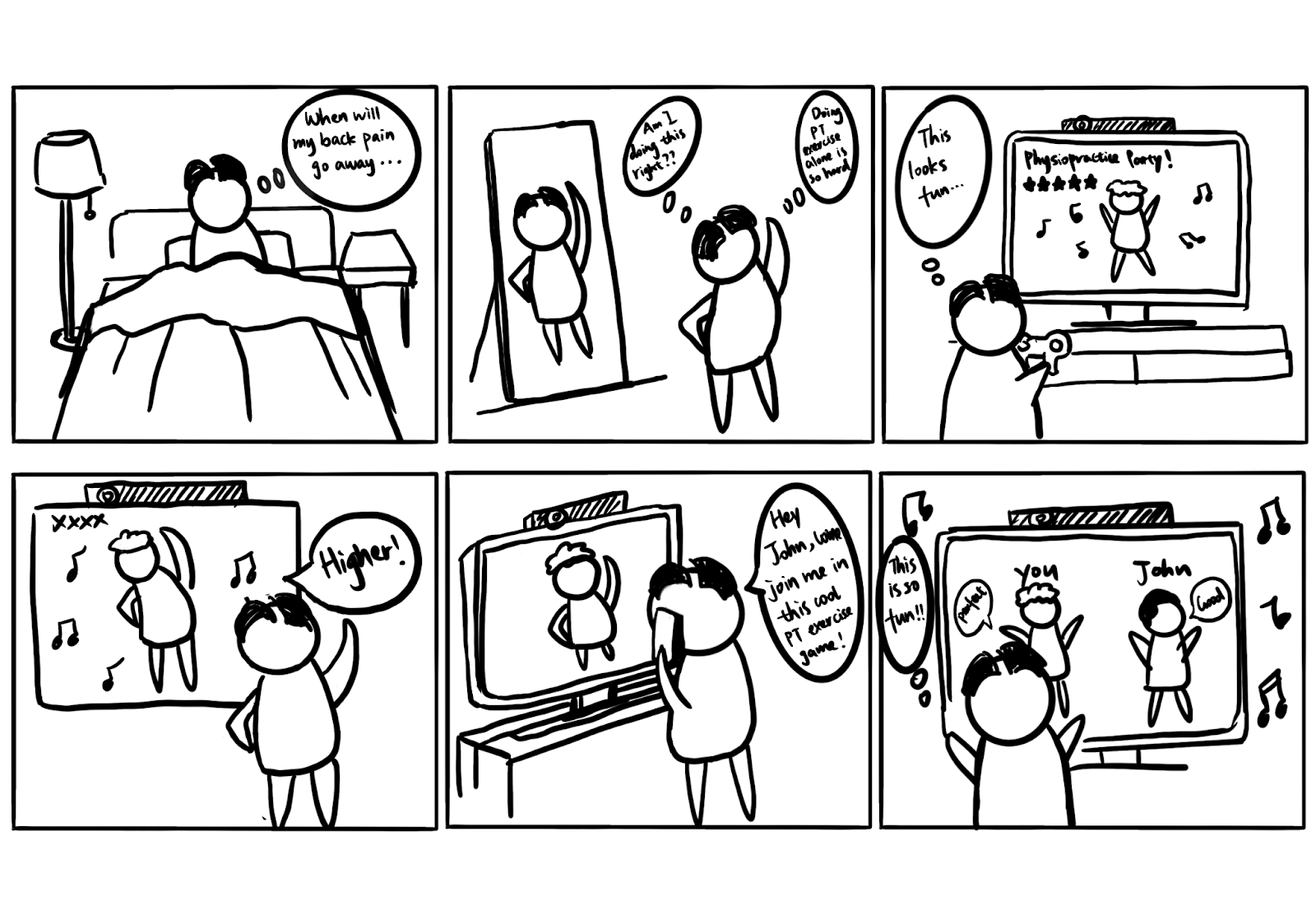P-Connect
The Problem
Physiotherapy clients have trouble sticking to the assigned at-home exercises between in-person sessions due to the lack of engagement and inefficient communication with physical therapists outside of the clinic. Lack of motivation and fear of further injury often stops clients from performing the exercises that could facilitate and speed up their recovery from injury. Therefore, how might we enhance the experience of virtual physiotherapy?
The Intervention
P-Connect is a mobile application that empowers and enables our users by providing an interactive way to perform assigned exercises at home in between in-clinic sessions. We provide feedback for users to know if they are performing the exercises with proper form and track the progress to keep them motivated. P-Connect also allows physiotherapists and patients to communicate with each other between sessions so that physiotherapists can address client concerns about form and pain.
My Role
Lead UX Researcher and Project Manager
Timeline
August 2022 - December 2022
Team Members
Roo Qian, Sydney Lodge, Plamen Tassev
Key Skills
comparative analyses, survey design and analysis, semi-structured interviews, observation, task-based and think-aloud user testing
THE RESEARCH APPROACH
We planned our preliminary research through framing and scoping questions — Who was our user group? What were our users’ wants and needs? What were the practices and goals related to the topic? Who were our stakeholders? What were the existing systems that attempted to address the problem space?
We conducted a literature review to understand physiotherapy efficacy…
We conducted a competitive analysis because…
BACKGROUND FROM THE LITERATURE REVIEW
percentage of people who attend only one or two in-person physiotherapy sessions
people seeking physiotherapy in the US per year on average
We conducted interviews because…
We conducted a survey because…
percent of people believe physiotherapy is most effective solution for long-term or drug-free pain relief
Many individuals stop going to a traditional physiotherapy practice primarily due to logistics with money, time, transportation, and health problems that require them to stay at home.
SURVEY
The primary purpose of our Qualtrics survey was to examine patterns of the pain points and needs of those with chronic pain and gain a high-level understanding of perceptions regarding physiotherapy and rehabilitation. Our questions were focused around peoples’ current habits and behaviors, as well as their processes for finding, attending, and facing hurdles in physiotherapy clinics.
In one week, we received 42 responses from people with chronic pain, with a diverse makeup of various socioeconomic backgrounds, job titles, and requests. Our participants ranged from not having attended any physiotherapy sessions to having completed their prescribed number of sessions. The survey further acted as a source of recruitment for interview participants.
of respondents experienced chronic pain for over two years
of respondents reported that their availability for practicing physiotherapy exercises changes every day.
of respondents stopped in-person physical therapy because of money, transportation, or time issues
of respondents are currently not engaging in physical therapy for their continuing pain
of respondents experienced pain in their leg(s), shoulder(s), or feet
SEMI-STRUCTURED INTERVIEWS WITH PHYSIOTHERAPY CLIENTS
Using the survey as a recruitment tool, we interviewed 8 participants for approximately one hour each to gain more in-depth information about their habits, attitudes, preferences, perceived barriers, and limitations. The semi-structured interview format allowed team members to let interviewees take the lead if they were passionate about a specific area. Another strength of this method was the ability to ask follow-up questions.
The affinity map that our team constructed from the target user semi-structured interviews to identify themes, form insights, and brainstorm design ideas.
SEMI-STRUCTURED INTERVIEWS WITH PRACTICING PHYSIOTHERAPISTS
We chose to do interviews with physiotherapists because we understood that there are intricacies to physiotherapy that our team members did not understand at the time. Our primary interview goals were to learn from subject-matter experts about how they supplement their work with technology, perceptions of current practices, how they motivate their clients, current retention and progress rates, and what they believe is important within the client-practitioner relationship. Further, we were curious as to whether and how tele-health has changed since the COVID-19 pandemic.
When the team began this project, we thought that we might want to replace in-person physiotherapy altogether. These interviews with physiotherapists helped us understand the importance of their work and the individual care and evaluation each client is given. As you will see later in the paper, we have brainstormed how we can reduce in-person physiotherapy sessions to still address the barriers regarding money, time, and transportation. However, we have also focused more on how to enhance virtual physiotherapy or exercise in between sessions to ensure that this reduction does not negatively harm physiotherapy clients’ long-term progress. We spoke to 4 physiotherapists over the course of a week.
OBSERVATION
We conducted observation sessions at 2 clinics in the Atlanta metro area. During these sessions, we obtained verbal and written consent from physiotherapists and clients in the space and each observation session was 2 hours long…
TASK ANALYSIS
KEY FINDINGS
The task analysis we created to understand the sequence of steps physical therapists and their clients take and identify potential problems.
DESIGN REQUIREMENTS
Storyboards visualizing the process of virtual physical therapy and traditional, in-person physical therapy (respectively)
Our visual style created through the prototyping process
The team using brainstorming techniques such as Crazy 8 and the Disney Method (Outsider, Dreamer, Realizer, and Critic) - guess who’s who :)
A few ideas that resulted from the aforementioned brainstorming
DESIGN EVALUATION
Research and design were an iterative process, and the team evaluated the designs at the concept, mid-fidelity, and high-fidelity levels. The design evaluation methods we used were cognitive walkthroughs, think-aloud task-based testing and expert heuristic evaluations.
TASK-BASED USER TESTING
Objective: test whether we were creating a user interface that is simple, discoverable, and easy to understand for our target user group as well as meeting their needs.
HEURISTIC EVALUATIONS
Objective: uncover the common usability issues that experts can quickly identify following the heuristic principles.
After a cognitive walkthrough, we asked 4 participants to spend an additional 20-30 minutes on completing a heuristic evaluation. The evaluation was adapted from Nielson Norman’s Usability Heuristics for User Interface Designs. We developed questions that were specific to our project and asked the experts to rate them on a scale from 1-5 (1 - strongly disagree; 5 - strongly agree).
REFLECTION
Throughout this process, research informed every one of our decisions. Further, this project was one of my first end-to-end UX projects. I therefore learned that research and design are both highly iterative processes and that feedback is especially valuable early in the process.
I honed my existing research skills in surveys, interviews, and data analysis while learning new research methods such as conducting task-based user testing, cognitive walkthroughs, and heuristic evaluations. From the standpoint of productive team dynamics, this project reaffirmed that collaboration and judgement-free brainstorming environments create the best solutions.




































